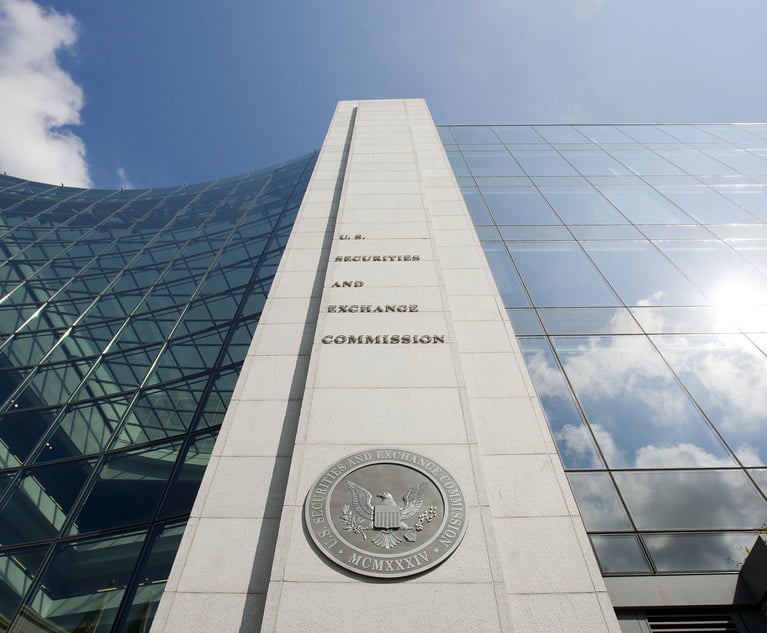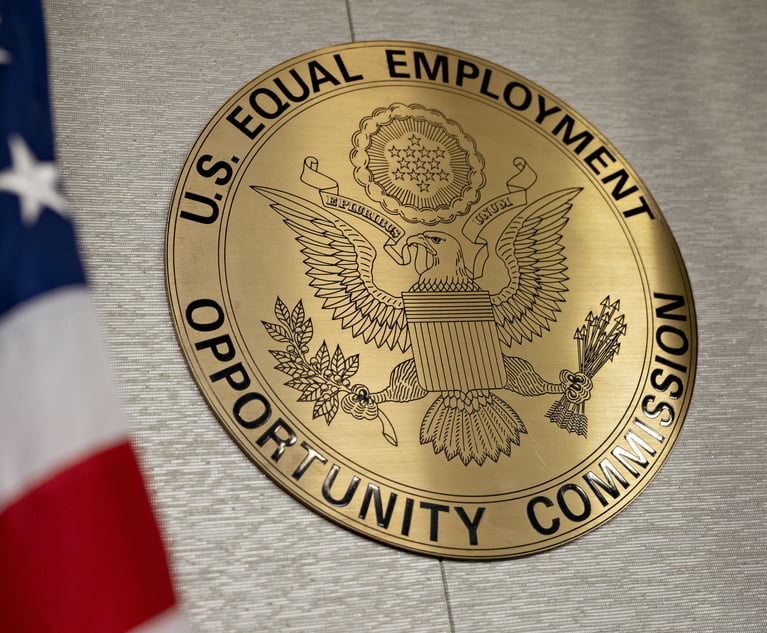Litigation: Preservation obligations after a duty to preserve has been triggered
Once the duty to preserve evidence has been triggered, the scope of the preservation obligation is the next issue for an organization to consider.
June 06, 2013 at 06:49 AM
7 minute read
The original version of this story was published on Law.com
Once the duty to preserve evidence has been triggered, the scope of the preservation obligation is the next issue for an organization to consider. Although there are guidelines from case law discussing the scope of the preservation duty, the cases are not consistent across the states, the federal circuits or even in individual district courts. As a result, organizations vulnerable to litigation in more than one jurisdiction, “cannot look to any single standard to measure the appropriateness of their preservation activities, or their exposure or potential liability for failure to fulfill their preservation duties,” according to the decision in Victor Stanley, Inc. v. Creative Pipe, Inc.
Since a national organization cannot effectively operate with a different preservation policy for each state and federal circuit, how does an organization respond to a preservation trigger? The only “safe” way to respond is to design a policy or response protocol that will satisfy the most demanding requirements of courts that have addressed the issue, even though that may impose burdens and expenses that exceed what is required in other jurisdictions in which they conduct business activities.
Once the duty to preserve is triggered, a company should err on the side of caution when deciding what to safeguard since “relevance” is very broad under the state and federal rules of civil procedure. Not only must an organization with notice of actual or potential litigation preserve potentially relevant evidence in its possession, it also must safeguard potentially relevant evidence under its control. Ordinarily, a document is under a litigant's control when it has the “right, authority, or practical ability to obtain the documents from a non-party to the action.” Id. But in some jurisdictions, courts also require a litigant to notify an opponent if potentially relevant evidence is in the hands of a third party.
When deciding what to preserve, an organization should identify the relevant time period, subject matter and location of potentially relevant information. Beyond that, determining the scope of the duty requires nuance because a court will determine what was reasonable under the specific circumstances and will consider whether there were “reasonable and good faith efforts to retain information that may be relevant to pending or threatened litigation.” The Sedona Conference, The Sedona Principles: Best Practices Recommendations & Principles for Addressing Electronic Document Production. Therefore, when determining what information to preserve, an organization should preserve the documents, data and things necessary to prosecute or to defend its case. Beyond that, an organization must consider a potential opponent's theory of the case because the duty to preserve extends to the data and documents that may be helpful and relevant to the case of the company's opponent.
Some courts have suggested that the scope of the duty to preserve discovery material should be proportional to the amount in controversy and the costs and burdens of preserving the information based on the scope of discovery provided in Rule 26 of the Federal Rules of Civil Procedure. But other courts have indicated that this standard may be “too amorphous” to be of much guidance to a party deciding what files or data it may delete or which backup tapes it may recycle because proportionality is a “highly elastic concept.” One Comm's, Inc. v. Numerex Corp. As a result, several courts have rejected that standard as imprudent and indicated that unless operating under a court-imposed preservation order, an organization cannot rely on the proportionality standard to create a safe harbor. So, until there is a more precise definition created by rule or case law, prudence favors issuing a broad legal hold notice and preserving all relevant materials in the organization's possession, custody or control. Alternatively or in addition, once litigation is commenced an organization may want to consider promptly obtaining a specific preservation order. We will discuss the appropriate components of a legal hold notice in our next post.
Once the duty to preserve evidence has been triggered, the scope of the preservation obligation is the next issue for an organization to consider. Although there are guidelines from case law discussing the scope of the preservation duty, the cases are not consistent across the states, the federal circuits or even in individual district courts. As a result, organizations vulnerable to litigation in more than one jurisdiction, “cannot look to any single standard to measure the appropriateness of their preservation activities, or their exposure or potential liability for failure to fulfill their preservation duties,” according to the decision in Victor Stanley, Inc. v. Creative Pipe, Inc.
Since a national organization cannot effectively operate with a different preservation policy for each state and federal circuit, how does an organization respond to a preservation trigger? The only “safe” way to respond is to design a policy or response protocol that will satisfy the most demanding requirements of courts that have addressed the issue, even though that may impose burdens and expenses that exceed what is required in other jurisdictions in which they conduct business activities.
Once the duty to preserve is triggered, a company should err on the side of caution when deciding what to safeguard since “relevance” is very broad under the state and federal rules of civil procedure. Not only must an organization with notice of actual or potential litigation preserve potentially relevant evidence in its possession, it also must safeguard potentially relevant evidence under its control. Ordinarily, a document is under a litigant's control when it has the “right, authority, or practical ability to obtain the documents from a non-party to the action.” Id. But in some jurisdictions, courts also require a litigant to notify an opponent if potentially relevant evidence is in the hands of a third party.
When deciding what to preserve, an organization should identify the relevant time period, subject matter and location of potentially relevant information. Beyond that, determining the scope of the duty requires nuance because a court will determine what was reasonable under the specific circumstances and will consider whether there were “reasonable and good faith efforts to retain information that may be relevant to pending or threatened litigation.” The Sedona Conference, The Sedona Principles: Best Practices Recommendations & Principles for Addressing Electronic Document Production. Therefore, when determining what information to preserve, an organization should preserve the documents, data and things necessary to prosecute or to defend its case. Beyond that, an organization must consider a potential opponent's theory of the case because the duty to preserve extends to the data and documents that may be helpful and relevant to the case of the company's opponent.
Some courts have suggested that the scope of the duty to preserve discovery material should be proportional to the amount in controversy and the costs and burdens of preserving the information based on the scope of discovery provided in Rule 26 of the Federal Rules of Civil Procedure. But other courts have indicated that this standard may be “too amorphous” to be of much guidance to a party deciding what files or data it may delete or which backup tapes it may recycle because proportionality is a “highly elastic concept.” One Comm's, Inc. v. Numerex Corp. As a result, several courts have rejected that standard as imprudent and indicated that unless operating under a court-imposed preservation order, an organization cannot rely on the proportionality standard to create a safe harbor. So, until there is a more precise definition created by rule or case law, prudence favors issuing a broad legal hold notice and preserving all relevant materials in the organization's possession, custody or control. Alternatively or in addition, once litigation is commenced an organization may want to consider promptly obtaining a specific preservation order. We will discuss the appropriate components of a legal hold notice in our next post.
This content has been archived. It is available through our partners, LexisNexis® and Bloomberg Law.
To view this content, please continue to their sites.
Not a Lexis Subscriber?
Subscribe Now
Not a Bloomberg Law Subscriber?
Subscribe Now
NOT FOR REPRINT
© 2025 ALM Global, LLC, All Rights Reserved. Request academic re-use from www.copyright.com. All other uses, submit a request to [email protected]. For more information visit Asset & Logo Licensing.
You Might Like
View All

Trending Stories
- 1Uber Files RICO Suit Against Plaintiff-Side Firms Alleging Fraudulent Injury Claims
- 2The Law Firm Disrupted: Scrutinizing the Elephant More Than the Mouse
- 3Inherent Diminished Value Damages Unavailable to 3rd-Party Claimants, Court Says
- 4Pa. Defense Firm Sued by Client Over Ex-Eagles Player's $43.5M Med Mal Win
- 5Losses Mount at Morris Manning, but Departing Ex-Chair Stays Bullish About His Old Firm's Future
Who Got The Work
J. Brugh Lower of Gibbons has entered an appearance for industrial equipment supplier Devco Corporation in a pending trademark infringement lawsuit. The suit, accusing the defendant of selling knock-off Graco products, was filed Dec. 18 in New Jersey District Court by Rivkin Radler on behalf of Graco Inc. and Graco Minnesota. The case, assigned to U.S. District Judge Zahid N. Quraishi, is 3:24-cv-11294, Graco Inc. et al v. Devco Corporation.
Who Got The Work
Rebecca Maller-Stein and Kent A. Yalowitz of Arnold & Porter Kaye Scholer have entered their appearances for Hanaco Venture Capital and its executives, Lior Prosor and David Frankel, in a pending securities lawsuit. The action, filed on Dec. 24 in New York Southern District Court by Zell, Aron & Co. on behalf of Goldeneye Advisors, accuses the defendants of negligently and fraudulently managing the plaintiff's $1 million investment. The case, assigned to U.S. District Judge Vernon S. Broderick, is 1:24-cv-09918, Goldeneye Advisors, LLC v. Hanaco Venture Capital, Ltd. et al.
Who Got The Work
Attorneys from A&O Shearman has stepped in as defense counsel for Toronto-Dominion Bank and other defendants in a pending securities class action. The suit, filed Dec. 11 in New York Southern District Court by Bleichmar Fonti & Auld, accuses the defendants of concealing the bank's 'pervasive' deficiencies in regards to its compliance with the Bank Secrecy Act and the quality of its anti-money laundering controls. The case, assigned to U.S. District Judge Arun Subramanian, is 1:24-cv-09445, Gonzalez v. The Toronto-Dominion Bank et al.
Who Got The Work
Crown Castle International, a Pennsylvania company providing shared communications infrastructure, has turned to Luke D. Wolf of Gordon Rees Scully Mansukhani to fend off a pending breach-of-contract lawsuit. The court action, filed Nov. 25 in Michigan Eastern District Court by Hooper Hathaway PC on behalf of The Town Residences LLC, accuses Crown Castle of failing to transfer approximately $30,000 in utility payments from T-Mobile in breach of a roof-top lease and assignment agreement. The case, assigned to U.S. District Judge Susan K. Declercq, is 2:24-cv-13131, The Town Residences LLC v. T-Mobile US, Inc. et al.
Who Got The Work
Wilfred P. Coronato and Daniel M. Schwartz of McCarter & English have stepped in as defense counsel to Electrolux Home Products Inc. in a pending product liability lawsuit. The court action, filed Nov. 26 in New York Eastern District Court by Poulos Lopiccolo PC and Nagel Rice LLP on behalf of David Stern, alleges that the defendant's refrigerators’ drawers and shelving repeatedly break and fall apart within months after purchase. The case, assigned to U.S. District Judge Joan M. Azrack, is 2:24-cv-08204, Stern v. Electrolux Home Products, Inc.
Featured Firms
Law Offices of Gary Martin Hays & Associates, P.C.
(470) 294-1674
Law Offices of Mark E. Salomone
(857) 444-6468
Smith & Hassler
(713) 739-1250







